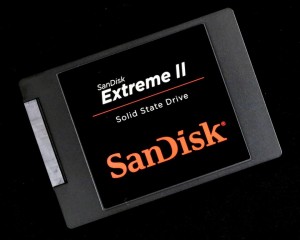 A few weeks ago we posted a review on the SanDisk Extreme II 240GB capacity SSD and it turned out to be one of the stronger contenders we have seen to date, and most definitely the strongest using a Marvell controller.
A few weeks ago we posted a review on the SanDisk Extreme II 240GB capacity SSD and it turned out to be one of the stronger contenders we have seen to date, and most definitely the strongest using a Marvell controller.
We wanted to today follow that up with an analysis of that same drive, this time in the 480GB capacity, as a form of confirmation that this SSD has what it takes to stand up there with the best.
Just prior to release of the SanDisk Extreme II, the SanDisk Extreme SSD was holding its own as one of the best SSDs available and its price point was one of the lowest seen. Amazon sales of the Extreme had remained at number one for several months and the Extreme’s price point played a significant role in helping drop the pricing model of SSDs, as a whole, in the consumer industry. If you have bought an SSD in the last while, regardless of manufacture, you can thank either SanDisk or Crucial as both have held valuable roles in today’s pricing of SSDs.

 The SanDisk Extreme II 6Gbps SSD is available in capacities of 120, 240 and 480GB and is a SATA 3 SSD, backwards compatible to SATA 2 systems, with a five year warranty. Performance of the Extreme II is variable, depending on capacity, and write performance drops a bit in the 120GB model to 340MB/s. Consistent in all three capacities, however, is the read performance above 550MB/s, as well as read and write IOPS above 91000 and 73000. Pricing for the Extreme II has been extremely low since its first day of release and all capacities are close to or below that golden $1/GB price point. Watch Amazon pricing here.
The SanDisk Extreme II 6Gbps SSD is available in capacities of 120, 240 and 480GB and is a SATA 3 SSD, backwards compatible to SATA 2 systems, with a five year warranty. Performance of the Extreme II is variable, depending on capacity, and write performance drops a bit in the 120GB model to 340MB/s. Consistent in all three capacities, however, is the read performance above 550MB/s, as well as read and write IOPS above 91000 and 73000. Pricing for the Extreme II has been extremely low since its first day of release and all capacities are close to or below that golden $1/GB price point. Watch Amazon pricing here.![]()
The exterior casing of the Extreme II SSD consists of a plastic top that is screwed into the metal base by four screws that are hidden under the white branding sticker. The PCB contains a Marvell 88SS9187 controller, Samsung 512MB DRAM cache memory and eight modules of 64GB 19nm ABL eX2 Toggle Mode NAND flash memory. As you can see with the photo above, each memory package, and that of the controller, contain a white insulator that is also attached to the aluminum base for effective heat dispersion.
In our last report, we described SanDisk’s proprietary nCache technology which adds to performance. The base of the PCB is very nondescript and contains no components worthy of mention.
 The SSD Review The Worlds Dedicated SSD Education and Review Resource |
The SSD Review The Worlds Dedicated SSD Education and Review Resource | 
While looking at the photo of the opened unit and seeing the thermal pads I started thinking it might be interesting to do temperature measurements on SSDs to see just how hot they can run. Case surface temp checks would give an overall surface reading but it would be neat to see realtime color thermal imaging (via a Fluke thermal imager handgun or equivalent). You’d then be able to see which chips ran hotter than the others. It would solve the question of what generates the most heat, reads or writes? Sequential or random? Large or 4K? RAID 0 or RAID 5? Are there operations that can generate enough heat to cause damage or shorten the lifespan of the unit? Just my $.02 worth (before taxes).
Thanks you for the great review I like the way you go through the whole details of each SSD you review. This is an amazing Solid States Drive, fast like an blink of an eye. works great in my Macbook Pro 2012, Just one thing I have noticed, it when I leave my MBP and it goes in sleep and I come back and wake it up, it takes 20-30 delay, couldn’t find a solution for it, except shutting it down and turn it on again because it takes 12 Sec to boot up.